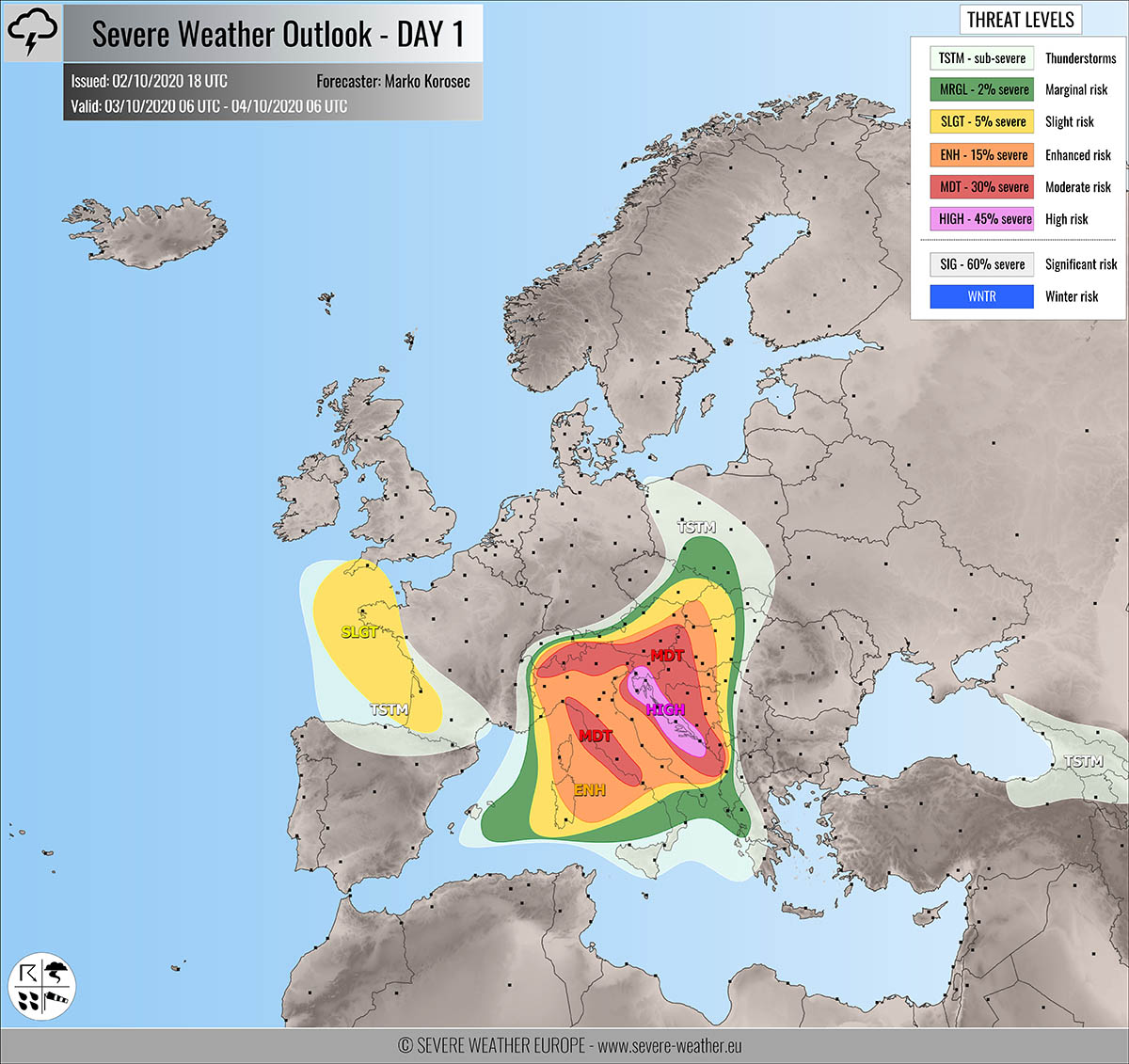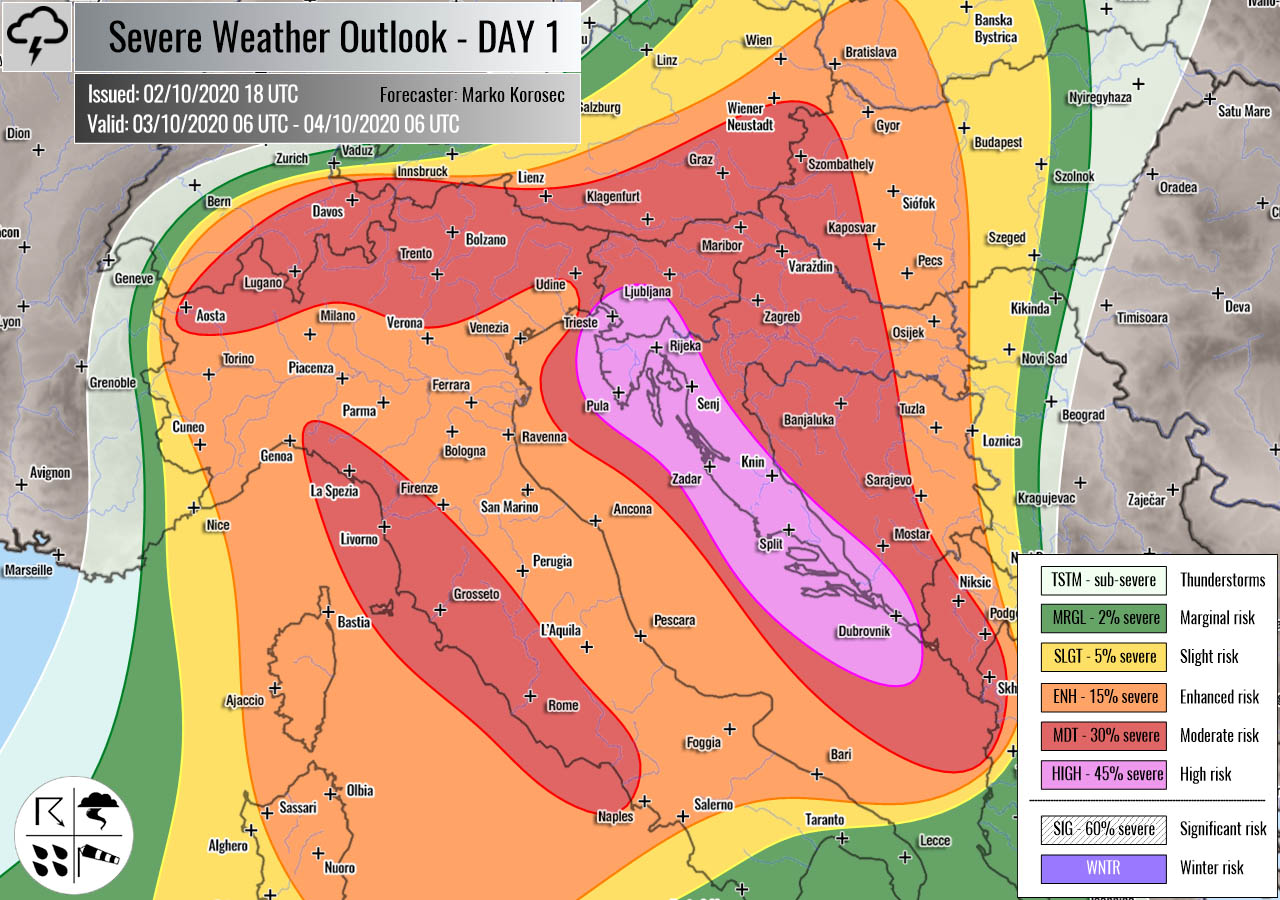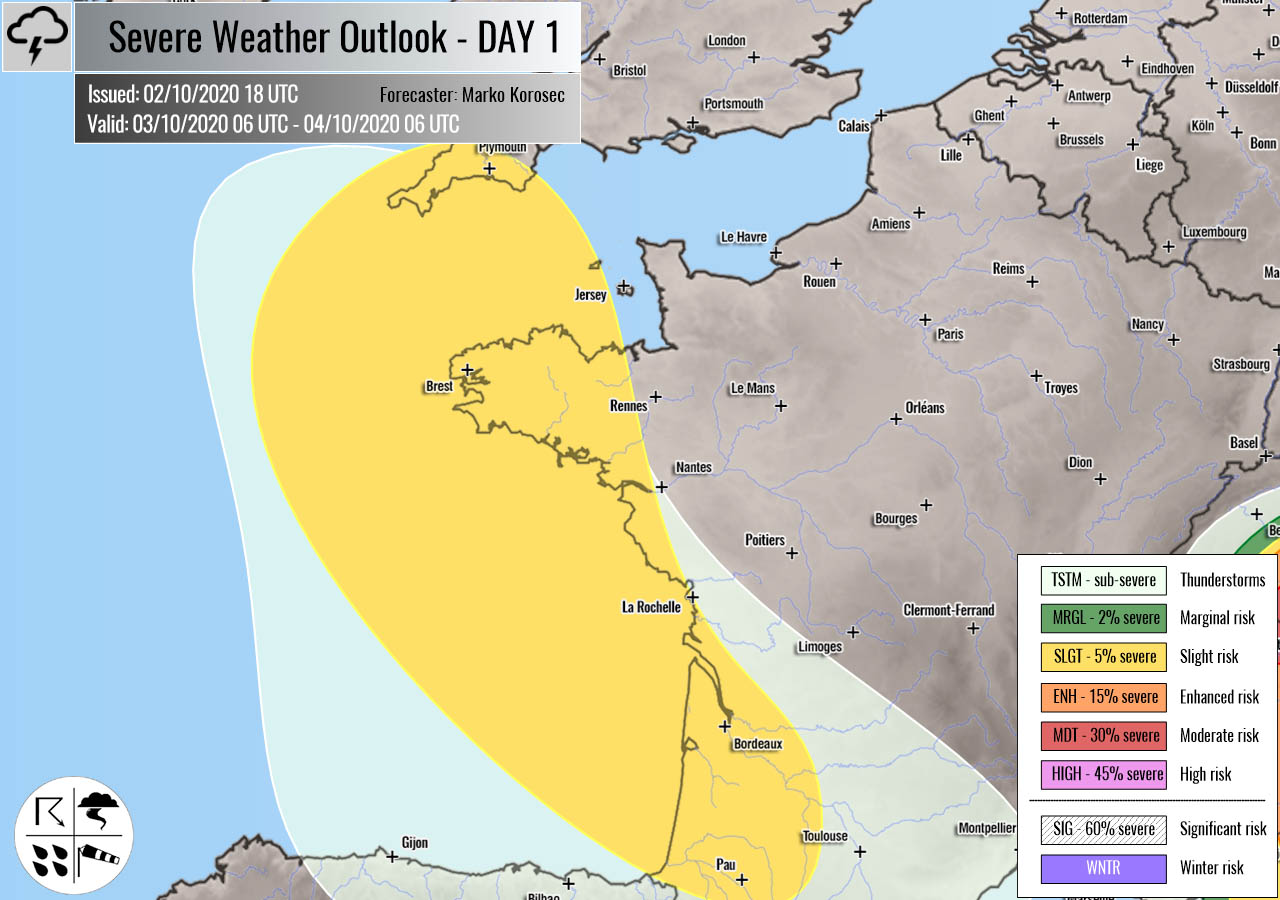Severe weather outlook – forecast across Europe. This forecast features areas of organized severe weather with risk levels and severe weather threats across the European continent.
SEVERE WEATHER OUTLOOK – DAY 1
Valid: 03/10/2020 06 UTC – 04/10/2020 06 UTC
Issued by: Severe Weather Europe
Forecaster: Marko Korošec
SUMMARY
A severe weather outbreak is forecast for parts of the north-central Mediterranean on Saturday. Widespread severe storms, including intense supercells, will be capable of producing destructive winds, tornadoes (possibly strong), torrential rainfall with flash floods, and large to very large hail. The threat is particularly extreme along the eastern Adriatic coast!
Overview of the risk areas across Europe
SYNOPTIC OVERVIEW
A large upper-level low is moving from western Europe towards the Alps and the northern Mediterranean. Surrounded by the upper ridge to its north, east, and over the Azores. At the surface, a deep low – storm Alex is rotating over France with an associated sharp cold front pushed east across Italy and the western Balkan peninsula.
FORECAST DISCUSSION
+++ Croatia, Slovenia, Italy, the Alps, Bosnia and Hungary +++
HIGH risk has been issued for southwestern Slovenia into western Croatia and southwestern Bosnia with a threat for widespread severe storms capable of producing severe damaging winds, torrential rainfall with flash floods, large to very large hail, and tornadoes.
MDT risk has been issued for central Italy with a threat for severe damaging winds, tornadoes, and torrential rainfall.
The overlap of a strengthening jet stream with a very moist boundary layer should support damaging storms to develop. Widespread convective activity is likely throughout the day and night to Sunday further east.
A severe weather outbreak is expected.
The main focus of interest will be the eastward-moving sharp cold front, associated with a deep storm Alex, centered over northern France. The front is advancing east along the approaching deep upper trough/low.
A large-scale upper-level forcing will overspread the warm sector, expanding over Italy, the Adriatic region, and across the western Balkan peninsula. Providing a favorable lift for widespread convection initiation along and ahead of the front.
A moderate to strongly unstable but extremely sheared (70-80 knots) environment is present ahead of the surface front. Nearly 1500-2000 J/kg of MLCAPE will accumulate across southern Italy, the Adriatic region, and western Balkan, even high further south.
The environment will be conducive for explosive and strongly organized storms, including intense supercells forming ahead of the main frontal line. The threat of damaging winds, tornadoes, large hail, and torrential rain will develop.
Very strong low-level shear and helicity, especially along the south-central Adriatic and the Tyrrhenian Sea will enhance the potential for strong tornadoes. This threat is limited to the discrete supercells, possibly forming ahead of the main frontal line.
MDT/ENH risks have been issued for areas surrounding the HIGH risk with a more isolated threat for severe winds and torrential/excessive rainfall.
Once the main frontal boundary enters from the west, an intense squall-line will likely develop. Therefore, supporting destructive winds and torrential rainfall.
A damaging line of storms, including embedded supercells, could develop and race east across the Adriatic region into Slovenia, Croatia, and Bosnia. The line should also remain well-organized further east across eastern Croatia, south Austria, and western Hungary.
A large, quasi-linear MCS (mesoscale convective system) will develop along the front, gradually moving east-northeast across the risk areas.
In addition to the severe wind threats, high rainfall amounts are expected along the mountain chains (Dynaric mountain range, Apennines, and the Southern Alps).
Huge amounts of rain should result from both torrential convective rainfall and strong, persistent orographic rainfall. Rainfall sums could reach 150-300 mm in some areas, leading to damaging flash floods.
For this reason, a HIGH risk for also extended into southwestern Slovenia as high rainfall sums are possible in a short, 6-12 hours period, leading to flash floods.
Another concern is the southerly Scirocco winds across the Adriatic Sea, being the strongest along the eastern Adriatic coast towards the northeast Italian coast.
A combination of strong winds, sea waves, and high tide could result in coastal flooding.
+++ SW England and France +++
SLGT risk has been issued for southwestern England into western and southwestern France with a threat for severe winds.
The wind threat is associated with a storm Alex, centered over northern France. A tight pressure gradient across the western side of the large depression should bring peak gusts locally in excess of 100 km/h.
Heavy rains should also develop across southern England into northwestern France, with gusty squalls possible. 50-100 mm of total rain will locally be possible.
See the initial Mesocale Discussion about Alex: An intense storm Alex is now forecast to strike Brittany and England with severe damaging winds on Friday
+++ other areas +++
TSTM risks have been issued for Poland and Georgia with a threat for daytime driven storms. Limited shear is present, so the storms should remain sub-severe.
Follow & report severe weather events on our Facebook page:
Severe Weather Europe Facebook page
Understanding Severe Weather Outlook
Severe Weather Outlook features areas of organized severe weather with risk levels and severe weather threats. Risk levels are divided into seven categories:
TSTM – Thunderstorms
MRGL – Marginal risk
SLGT – Slight risk
ENH – Enhanced risk
MDT – Moderate risk
HIGH – High risk
SIG – Significant risk
WNTR – Winter risk
Risk categories stand for the coverage and intensity of organized severe weather. Those could include supercells, squall lines, mesoscale convective systems, wind storms, flooding, snowstorms, or ice storms.
Severe weather threats include:
- large hail (of at least 2 cm in diameter)
- Tornadoes (including waterspouts)
- Wind gusts (convective or non-convective) above 25 m/s (or above 90 km/h)
- Torrential convective precipitation / Flash floods
- Excessive rainfall (100 mm within 12 hours) / snowfall (50 cm within 12 hours)
Extremely severe weather threats include:
- Large hail (of at least 5 cm in diameter)
- Tornadoes of F2 intensity or stronger
- Wind gusts (convective or non-convective) above 33 m/s (or above 119 km/h) or 12 Bft
- Torrential convective precipitation / Flash floods
- Excessive rainfall (150 mm within 12 hours or above ) / snowfall (above 100 cm within 24 hours)
Categories in the forecast represent the chance of severe weather occurring within a 40 km radius from a location. The used level is based on the conversion table of probabilistic risk into the outlook categories. A threat level is upgraded into a higher category if probabilities meet the threshold criteria for the specific threat (e.g. tornado, wind, hail, or rainfall threat).
Each individual threat area includes a detailed forecast map and discussion on the potential of severe weather threats.
Read more: Explanations for abbreviations (TSTM, SLGT, ENH, etc.)


